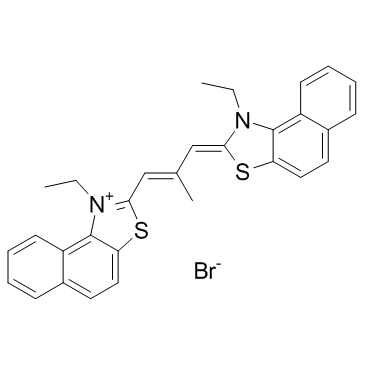Stains-All

Stains-All structure
|
Common Name | Stains-All | ||
|---|---|---|---|---|
| CAS Number | 7423-31-6 | Molecular Weight | 559.58300 | |
| Density | N/A | Boiling Point | N/A | |
| Molecular Formula | C30H27BrN2S2 | Melting Point | N/A | |
| MSDS | Chinese USA | Flash Point | N/A | |
|
Rotenone inhibits primary murine myotube formation via Raf-1 and ROCK2.
Biochim. Biophys. Acta 1853 , 1606-14, (2015) Rotenone (ROT) is a widely used inhibitor of complex I (CI), the first complex of the mitochondrial oxidative phosphorylation (OXPHOS) system. However, particularly at high concentrations ROT was also described to display off-target effects. Here we studied h... |
|
|
De novo design of an RNA tile that self-assembles into a homo-octameric nanoprism.
Nat. Commun. 6 , 5724, (2015) Rational, de novo design of RNA nanostructures can potentially integrate a wide array of structural and functional diversities. Such nanostructures have great promises in biomedical applications. Despite impressive progress in this field, all RNA building blo... |
|
|
Transcription of the Streptococcus pyogenes hyaluronic acid capsule biosynthesis operon is regulated by previously unknown upstream elements.
Infect. Immun. 82(12) , 5293-307, (2014) The important human pathogen Streptococcus pyogenes (group A Streptococcus [GAS]) produces a hyaluronic acid (HA) capsule that plays critical roles in immune evasion. Previous studies showed that the hasABC operon encoding the capsule biosynthesis enzymes is ... |
|
|
Comparison of sodium dodecyl sulfate depletion techniques for proteome analysis by mass spectrometry.
J. Chromatogr. A. 1418 , 158-66, (2015) In proteomics, sodium dodecyl sulfate (SDS) is favored for protein solubilization and mass-based separation (e.g. GELFrEE or SDS PAGE). Numerous SDS depletion techniques are available to purify proteins ahead of mass spectrometry. The effectiveness of the pur... |
|
|
Microfluidic Chip for Site-Specific Neuropharmacological Treatment and Activity Probing of 3D Neuronal "Optonet" Cultures.
Adv. Healthc. Mater. 4 , 1478-83, 1422, (2015) The study introduces a "brain-on-a-chip" microfluidic platform that hosts brain-like 3D cultures ("optonets") whose activity and responses to flowing drugs are recorded optically. Optonets are viable, optically accessible 3D neural networks whose characterist... |
|
|
Adhesive and migratory effects of phosphophoryn are modulated by flanking peptides of the integrin binding motif.
PLoS ONE 9(11) , e112490, (2014) Phosphophoryn (PP) is generated from the proteolytic cleavage of dentin sialophosphoprotein (DSPP). Gene duplications in the ancestor dentin matrix protein-1 (DMP-1) genomic sequence created the DSPP gene in toothed animals. PP and DMP-1 are phosphorylated ex... |
|
|
Relationship between length variations in Ser/Asp-rich repeats in phosphophoryn and in vitro precipitation of calcium phosphate.
Arch. Oral Biol. 60 , 1263-72, (2015) Phosphophoryn (PP) is generated from the proteolytic cleavage of dentin sialophosphoprotein (DSPP). PP which contains tandem serine/asparatic acid rich repeats (SDrr) is known to enhance dentin mineralization. The nucleotide sequences coding SDrr are identifi... |
|
|
Determination of hyaluronan molecular mass distribution in human breast milk.
Anal. Biochem. 474 , 78-88, (2015) Hyaluronan (HA) in human milk mediates host responses to microbial infection via TLR4- and CD44-dependent signaling. Signaling by HA is generally size specific. Because pure HA with average molecular mass (M) of 35 kDa can elicit a protective response in inte... |
|
|
Expression of developmentally regulated plasma membrane polypeptide (DREPP2) in rice root tip and interaction with Ca(2+)/CaM complex and microtubule.
Protoplasma 252 , 1519-27, (2015) The cytoplasmic free Ca(2+) could play an important role for salt tolerance in rice root (Oryza sativa L.). Here, we compared the expression profiles of two putative developmentally regulated plasma membrane polypeptides (DREPP1 and DREPP2) in rice roots of s... |
|
|
Anti-inflammatory activity of low molecular weight polysialic acid on human macrophages.
Sci. Rep. 5 , 16800, (2015) Oligosialic and polysialic acid (oligoSia and polySia) of the glycocalyx of neural and immune cells are linear chains, in which the sialic acid monomers are α2.8-glycosidically linked. Sialic acid-binding immunoglobulin-like lectin-11 (SIGLEC-11) is a primate... |